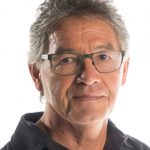Learn from members of one of Canada’s leading international river basin negotiating teams how they are working to restore ecosystem health in the Canadian portion of the Columbia Basin following the damming of the River in the 1960s.
This inspiring and informative webinar also explores how Living Lakes Canada, a grass roots group, is monitoring water quality, training both Indigenous and non Indigenous communities, and sharing all data on an open source data hub.
Speakers include: Barbara Cosens, a Professor of Law and Water Policy at the University of Idaho; Nathan Matthew, Chief of the Secwepemc First Nations community for over 20 years; Kat Harwig, international, national and regional environmental advocate for issues relating to sustainable tourism, endangered species, corporate social responsibility and water based ecosystem health; Raegan Mallinson, a Canadian Aquatic Biomonitoring Network (CABIN) certified Program Manager and Trainer; and Santiago Botero, a geographic information systems team member. Hosted by Jonathan O’Riordan, former Deputy Minister of the Environment.
Please scroll down below the speaker bios for additional Q&A.
“Thank you for this presentation on the NEW Columbia Basin Agreement. I remember the one established in 1964-56 years ago. I travelled with my dad who took us for a last drive around ‘the BIG Bend Highway” before flooding ocurred. He was very sad and I did not understand what was happening until later in my life.
I had the privilege of serving on the Fraser Basin Council for 4 years while Iona Campagnolo was the chair. All of my adult life I have been very interested in how we are handling our human impacts on both the Columbia and the Fraser River.
This presentation has given me hope that we are now recognize the ecological and cultural values as expressed by Nathan Matthews and others. Power and flood management were the main focus and now a bigger picture.
I took pages of notes from the presentation and will watch again. I am very grateful that you gave the focus to these magnificent rivers.
– W Turner.”
 Barbara Cosens is a Professor of Law and Water Policy at the University of Idaho. Her research is centred on the integration of law and science in education, water governance and dispute resolution. She is a member of the Universities Consortium on Columbia River Governance and an authority on international river basin treaties.
Barbara Cosens is a Professor of Law and Water Policy at the University of Idaho. Her research is centred on the integration of law and science in education, water governance and dispute resolution. She is a member of the Universities Consortium on Columbia River Governance and an authority on international river basin treaties.
She is an expert in adaptive governance for managing resilience in river basins in an era of changing climate.
 As Chief of the Secwepemc First Nations community for over 20 years, Nathan Matthew has supported and led many community-building initiatives in strategic planning, schooling, economic development, health and social development and governance.
As Chief of the Secwepemc First Nations community for over 20 years, Nathan Matthew has supported and led many community-building initiatives in strategic planning, schooling, economic development, health and social development and governance.
In addition to his political roles, Matthew has had a strong career in education. He has held significant roles in many institutions including Director of the UBC Short Course for Principals of First Nations Schools, from 1986 to 2005. Matthew was then Executive Director of Aboriginal Education at Thompson Rivers University from 2008 to 2012. He has been a leader in the local, provincial, and national dialogue on self-determination for Indigenous education.
 Kat Harwig grew up on her family ranch in the Southern Rockies of BC. She has been involved in international, national and regional environmental advocacy issues relating to sustainable tourism, endangered species, corporate social responsibility and water based ecosystem health since 1983.
Kat Harwig grew up on her family ranch in the Southern Rockies of BC. She has been involved in international, national and regional environmental advocacy issues relating to sustainable tourism, endangered species, corporate social responsibility and water based ecosystem health since 1983.
She is an advisor for the Lake Windermere Ambassadors; BC Water Leaders Consortium; Small Change Fund; Vancouver Foundation Environmental Advisory; Canadian Freshwater Alliance Advisory and the Columbia Basin Trust Climate Resilience Advisory. Her current board positions include the Columbia Basin Water Stewardship Network, North American Lake Management Society and German based Global Nature Fund.
 Raegan Mallinson grew up on the Eastern slopes of the Canadian Rockies, nestled in the Alberta foothills on Treaty 7 Territory, traditional territories of the Blackfoot Confederacy.
Raegan Mallinson grew up on the Eastern slopes of the Canadian Rockies, nestled in the Alberta foothills on Treaty 7 Territory, traditional territories of the Blackfoot Confederacy.
She received her BSc. from the University of Calgary in Environmental Science, has a certificate in Indigenous Relations Leadership and is a Canadian Aquatic Biomonitoring Network (CABIN) certified Program Manager and Trainer. She has worked with stewardship groups, Indigenous communities, academia and environmental consultants across Canada to develop aquatic monitoring with cutting edge genomics technologies to support biodiversity and source water protection. Raegan has also worked internationally in Colombia on watershed stewardship projects.
 Santiago Botero grew up in Ecuador, creating a fond love for nature through hiking, camping, and adventuring in the heart of the Andes. The call of the mountains and love for nature brought Santiago to British Columbia, where he is working towards a career in environmental science, conservation, and geospatial technology. Santiago graduated from the Integrated Environmental Planning Technology program at Selkirk College in 2019 and is currently entering his final year of a bachelor’s degree in Geographic Information Systems. He is passionate about people, nature, and technology, and believes in harmony between them all.
Santiago Botero grew up in Ecuador, creating a fond love for nature through hiking, camping, and adventuring in the heart of the Andes. The call of the mountains and love for nature brought Santiago to British Columbia, where he is working towards a career in environmental science, conservation, and geospatial technology. Santiago graduated from the Integrated Environmental Planning Technology program at Selkirk College in 2019 and is currently entering his final year of a bachelor’s degree in Geographic Information Systems. He is passionate about people, nature, and technology, and believes in harmony between them all.
Additional Q&A
Q. How are the dams allowing shipping of agriculture products?
A. Barb Cosens: The dams were built with locks to allow barge traffic to travel all the way to the inland port of Lewiston, Idaho.
Q. How, or will, these efforts be applied to other river systems and lakes within the province?
A. Jon O’Riordan: The BC Government passed the Water Sustainability Act in 2016. The Act and its regulations provide for protecting and restoring ecological function in watersheds and for rivers and lakes. The recent commitment to UNDRIP principles— UN Declaration on the Rights of Indigenous Peoples adds value to protecting aquatic based ecosystems.
Q. What will be the capital cost of dam modifications to achieve the goals and how will that funding be apportioned? When might this work begin?
A. Barb Cosens: I assume this refers to fish passage. I do not know the answer, but studies have been done to develop fish passage past Chief Joseph and Grand Coulee dams – the barriers to the mainstem of the river in Canada. The cost is high.
Q. In renegotiating the treaty how much input is federal, provincial/state and local government/groups?
A. Barb Cosens: From 2010 to 2013 the US federal agencies involved in river operation (US Army Corps of Engineers and Bonneville Power Administration); and separately the government of British Columbia undertook reviews of the existing Columbia River Treaty. For the Canadian review, the province did a robust process of public involvement. Local governments, First Nations, and interest groups organized provided substantial input. For the US review, a sovereign advisory committee was formed with 5 representatives of the 15 Tribes in the US portion of the basin and 1 representative of each of the 4 states affected by hydropower development. The US review team also held listening sessions around the basin for local government and citizen input. In addition, Northwest Power and Conservation Council and Columbia Basin Trust funded the Universities Consortium on Columbia River Governance (faculty and researchers from public universities on both sides of the border) to hold information sessions and dialogue to bring together common interests on both sides of the border.
Once negotiations commenced, participation at the table and public involvement is in the hands of the respective governments. British Columbia is at the table and BC and Canada extended observer status to First Nations, the United States invited Native Americans to the table as experts. Public meetings are held around the basin. On the US side, increased public engagement and observer status for states and tribes is one thing people seek from a new administration in the US.
Q. Does the current water flow management make allowances for fish, or is it simply flood control and shipping? And electricity generation of course.
A. Barb Cosens: As part of mitigation for salmon and steelhead listed under the US Endangered Species Act, water is spilled from US reservoirs to speed out migration of smolts. The Canadian share of power is calculated as if water spilled actually passed through turbines in the US.
Q. Is there a way that all concerns will be met?
A. Barb Cosens: While I don’t speak for the negotiators, if the parties stick with the spirit of the original treaty of seeking opportunities for joint benefits – the challenge and opportunity of carbon neutrality (something sought by both the Canadian government and President elect Biden), which requires keeping hydropower production high while restoring salmon runs and taking advantage on both sides of the border for riparian and floodplain restoration should allow them to overcome differences on the CE and may help solve some of the flood control concerns. That would leave the complexity of adding ecosystem function as a third prong and managing a changing system as the primary challenges – one we in the basin should welcome as an opportunity to lead the world in figuring out how this can be done.
Q. American jurists have developed the idea and the legal regime of a “public transnational law” for cooperation around a cross-border basin. This transnational law would allow governance “between all actors” across borders and for the unity of the basin. Is this theoretical-legal framework conceivable for the CRB and the renegotiations? My opinion is that dams are dinosaur technology. Are there new dams being built? ie accepted practice.. pls ignore the madness of Site C (BC Hydro)…in North America are there others?
A. Barb Cosens: I do not work in public transnational law, but there is considerable cross-border cooperation at the subnational local and regional level in the Columbia River Basin on everything from salmon recovery to transportation, to trade, to the electric grid.
Q. There are present studies on the Columbia river Below Castlegar for fish stranding but none on aquatic insect stranding. Is any one aware of any proposed studies for this area?
A. Jon O’Riordan: I do not have information on specific studies. I can advise that the Provincial government developed a water use plan for the Lower Columbia in Canada as part of a review of water released from hydro power facilities across the province to balance power production with other values such as fish production and passage, recreation and wildlife. I believe the water use plan for the Columbia will soon be subject to a review.
Q. I’m not a technical person, but aren’t there turbines that can be placed in rivers to generate power?
A. Barb Cosens: Yes, it is called hydrokinetics. I’m no expert, but I believe that currently the technology is relevant to small scale power generation such as in irrigation canals. You can think of it like roof-top solar. If adopted by many, it can have an impact and could be one more factor in a carbon neutral system.
Q. How are the data for maintaining the health of rivers and streams fed into improving practices in forestry, agricultural, mining and other industries?
A. Jon O’Riordan: The province has developed an integrated data information system linking data across natural resources sectors. The federal government is proposing to establish a Canada Water Agency which would consolidate all data and monitoring of water based systems across the country. The monitoring program outlined by Living Lakes Canada is open source and would provide some of the data noted in the question.
Q. Quick question for a BC rep: looking at the map being used, it appears that the Okanagan Basin in BC is still not included in BC’s vision of the Columbia Basin, even though certain mgmt. obligations under the CRT negatively impact flows for out-migrating juvenile salmon from the Okanagan River. How will BC address those impacts and rectify the flow issue for Okanagan origin salmon?
A. Jon O’Riordan: The provincial government has included the Okanagan Nation Alliance — the indigenous groups in the Similkameen section of the Canadian Columbia basin– to attend as observers to the negotiations. The ONA will bring these issues to the negotiating table. In addition the ONA signed the Letter Of Agreement with the federal and provincial government to examine how fish passage can be assured into the Canadian Columbia system including the Similkameen River.